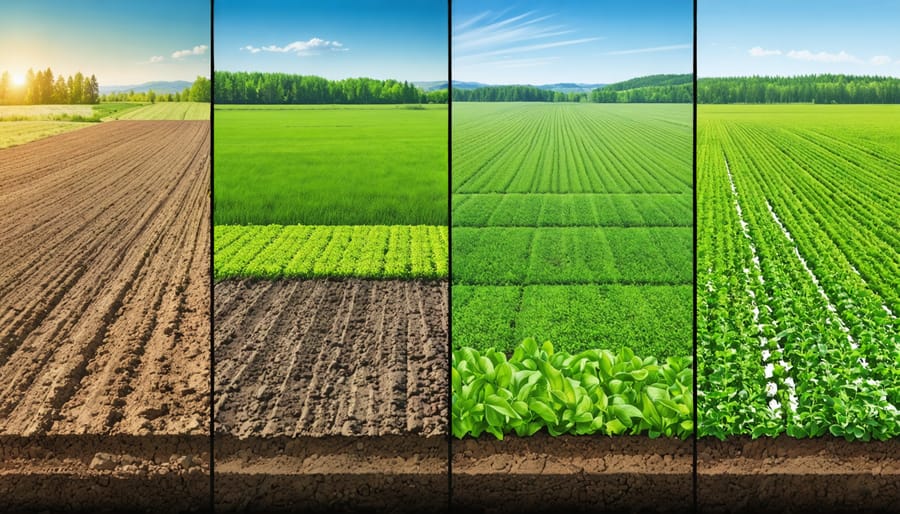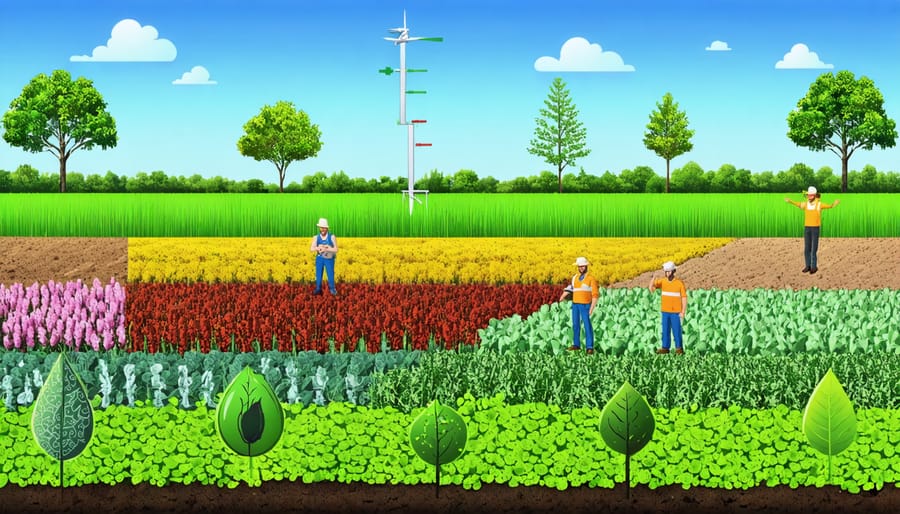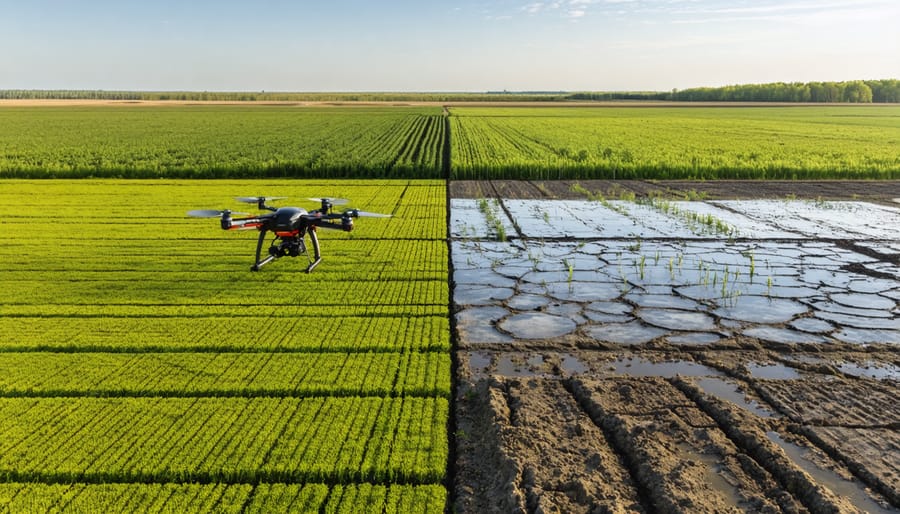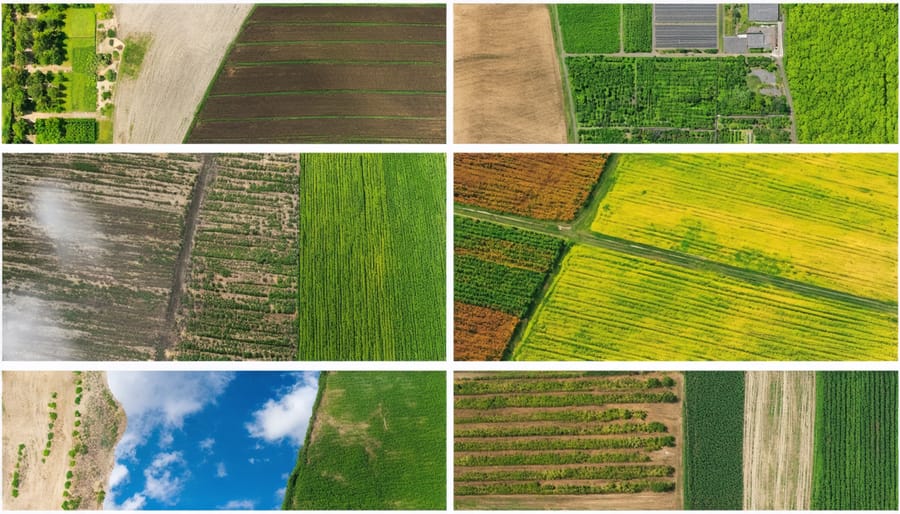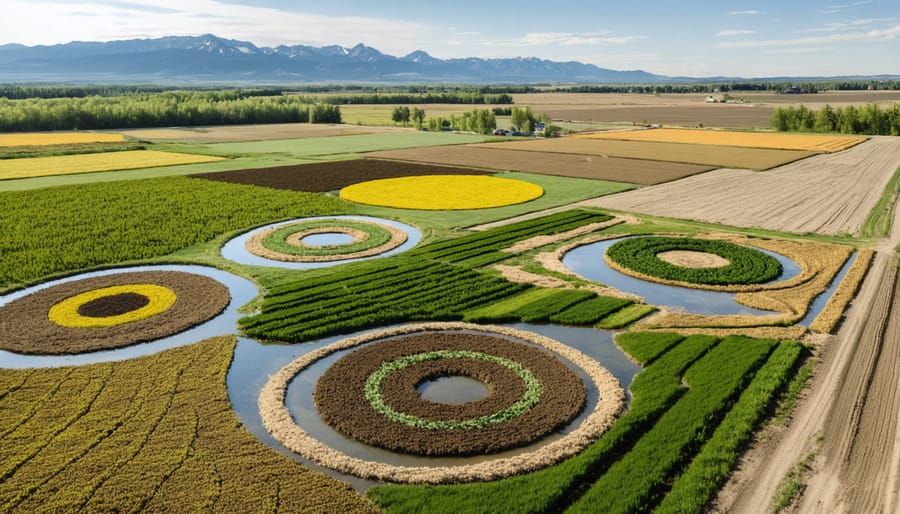Test soil pH levels annually using a reliable digital meter to establish your baseline and track changes across different field sections. Managing soil acidity through precise liming stands as one of the most crucial soil health fundamentals for Alberta farmers, directly impacting crop yields and nutrient availability. Apply agricultural lime at rates between 2-4 tonnes per hectare during fall cultivation, allowing winter moisture to help incorporate the material into your soil profile. Calculate your lime requirements using both your current pH readings and target levels, factoring in your soil’s buffering capacity and organic matter content.
Monitor results every three months after application, particularly in areas where acidic soils historically challenge crop performance. Prairie soils typically require careful pH management due to their natural tendencies toward acidification, especially in regions with high rainfall or intensive nitrogen fertilizer use. Proper liming not only corrects soil acidity but also improves nutrient uptake, enhances beneficial microbial activity, and strengthens root development across your entire field system.
Understanding Soil Acidity in Alberta
Common Causes of Soil Acidification
In Alberta’s agricultural landscape, several key factors contribute to soil acidification. Intensive farming practices, particularly the heavy use of nitrogen-based fertilizers, are a primary cause. These fertilizers, while essential for crop growth, can gradually lower soil pH through nitrification processes. The region’s naturally acidic parent materials, combined with high rainfall areas in parts of central and northern Alberta, accelerate this acidification.
Another significant factor is crop removal during harvest, which depletes essential base cations from the soil. Modern high-yielding varieties, while productive, can intensify this effect. Additionally, proper soil organic matter management plays a crucial role, as declining organic matter levels can reduce the soil’s buffering capacity against pH changes.
Local weather patterns, particularly in regions experiencing acid rain, can further compound these issues. Many Alberta farmers have noticed increased soil acidity following years of continuous cropping without regular soil testing and amendment programs. Understanding these regional factors helps develop targeted solutions for maintaining optimal soil pH levels and ensuring long-term soil health.
Signs Your Soil Needs Liming
Regular soil testing is your best tool for determining if your soil needs liming, but there are several visible signs that can alert you to acidic soil conditions. Watch for stunted crop growth, particularly in legumes like alfalfa and clover, which are especially sensitive to low pH. You might notice yellowing between leaf veins in your crops, indicating nutrient deficiencies that often occur in acidic soils.
The presence of certain weeds can also signal acidic conditions. If you’re seeing an abundance of sorrel, plantain, or moss in your fields, it’s time to check your soil pH. Another telling sign is when fertilizer applications don’t seem to improve crop performance – acidic soil can lock up nutrients, making them unavailable to plants.
In Alberta’s agricultural regions, soil pH typically ranges from 6.0 to 7.5. If you suspect acidity issues, start with a comprehensive soil test from an accredited laboratory. Many agricultural extension offices across Alberta offer soil testing services and can help interpret your results. Remember to test different areas of your field, as soil pH can vary significantly across your land.
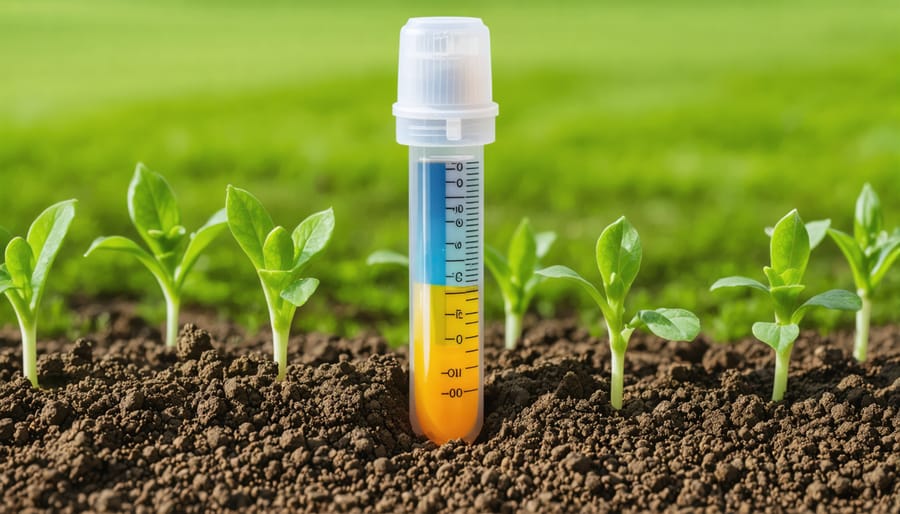
Liming Materials and Methods
Types of Lime Available in Alberta
In Alberta, farmers have access to several effective liming materials, each with unique properties suited to different soil conditions. Agricultural lime (calcium carbonate) is the most commonly available option, sourced from local quarries and particularly effective for our prairie soils. This type typically comes in a finely ground form, making it easier to spread and quicker to react with soil.
Dolomitic lime, containing both calcium and magnesium carbonates, is another valuable option, especially beneficial for soils lacking in magnesium. While slightly more expensive than regular agricultural lime, it provides additional nutritional benefits that can justify the cost for many Alberta operations.
Quick lime (calcium oxide) and hydrated lime (calcium hydroxide) are also available but require more careful handling due to their caustic nature. These forms react more rapidly with soil and are particularly useful when faster pH adjustment is needed, though they’re typically more expensive than agricultural lime.
A newer option gaining popularity is pelletized lime, which combines the effectiveness of finely ground limestone with easier handling and spreading characteristics. While it comes at a premium price, many Alberta farmers find the convenience worth the investment, especially for smaller acreages.
Local suppliers often stock lime products in various mesh sizes, with finer materials reacting more quickly but potentially being more challenging to spread. Most agricultural suppliers across the province can help farmers select the most appropriate type based on their specific soil needs and operational requirements.
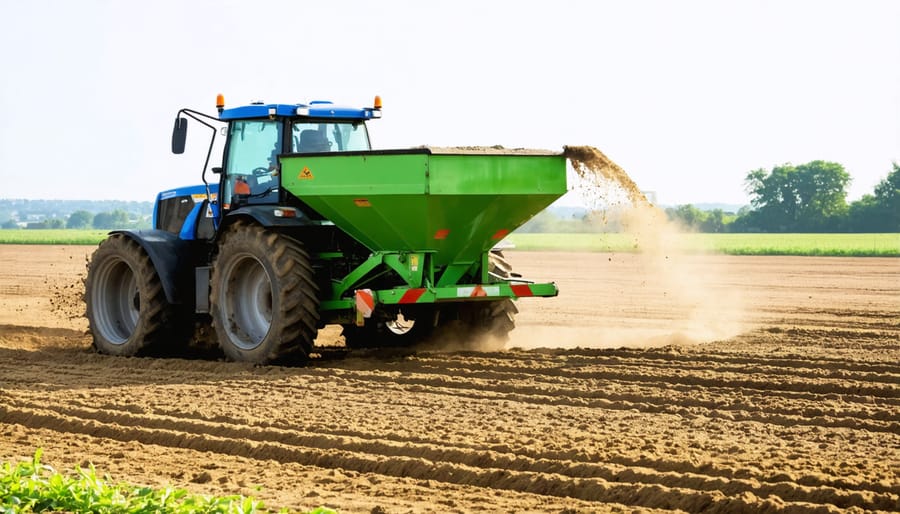
Application Timing and Methods
In Alberta’s climate, timing your lime application correctly is crucial for optimal results. The best time to apply lime is typically in the fall after harvest or in early spring before seeding. Fall applications are particularly effective as winter freeze-thaw cycles help incorporate the lime into the soil naturally.
For best results, apply lime when soil conditions are relatively dry but not dusty. Avoid spreading during high winds or when heavy rain is forecasted within 48 hours. If applying in spring, aim to complete the process at least two weeks before seeding to allow time for the lime to start reacting with the soil.
The most common application method in Alberta is broadcasting, either with a standard fertilizer spreader or specialized lime spreader. For larger operations, many farmers opt for commercial spreading services that use GPS-guided equipment for precise application. Ensure even distribution by maintaining consistent speed and following proper calibration procedures.
The application rate depends on your soil test results and the lime’s calcium carbonate equivalent (CCE). Most Alberta soils require between 2 to 4 tonnes per hectare, though rates can vary significantly. It’s often better to apply lime in smaller amounts over multiple years rather than one large application, especially in no-till operations.
For smaller areas, such as market gardens or hobby farms, hand spreading is practical but should still be done uniformly. Water the area lightly after application to help initiate soil contact.
Real Results: Alberta Farm Case Studies
Central Alberta Grain Farm Success Story
The Watson family farm, located just outside Red Deer, Alberta, has become a shining example of successful pH management through proven soil management techniques. In 2019, after noticing declining canola yields and struggling wheat crops, soil tests revealed their 640-acre operation had acidic soils ranging from pH 5.2 to 5.8.
Working with local agronomists, they developed a three-year liming program, applying 2 tonnes per acre of calcium carbonate limestone in phases. The initial application focused on their most acidic fields, using locally sourced lime to keep costs manageable. They incorporated the lime during fall tillage, allowing winter conditions to help with soil integration.
By 2022, their soil pH had stabilized between 6.2 and 6.8, leading to remarkable improvements. Wheat yields increased by 23%, while canola production showed a 17% boost. The Watsons also noticed better nutrient uptake efficiency and improved soil structure, resulting in better water retention during dry spells.
The total investment of $85,000 was recovered within two growing seasons through increased yield and reduced fertilizer requirements, making this a compelling example of successful pH management in Central Alberta’s agricultural landscape.

Peace Region Mixed Farm Experience
In the heart of Alberta’s Peace Region, Sarah and Jim Thompson’s mixed farming operation faced persistent challenges with acidic soils across their 2,000-hectare property. Initial soil tests revealed pH levels ranging from 5.2 to 5.8, significantly impacting their canola and barley yields.
The Thompsons implemented a targeted liming program in 2019, applying 2.5 tonnes of agricultural lime per hectare on their most affected fields. They chose to work with locally sourced limestone, which helped reduce transportation costs while supporting regional suppliers.
“We noticed improvements within the first growing season,” Sarah explains. “Our soil structure became more workable, and nutrient uptake visibly improved.” Their systematic approach included dividing their land into management zones based on pH levels and crop rotation patterns.
After three years, soil tests showed pH levels had risen to 6.2-6.5 in treated areas. Barley yields increased by 15%, while canola production saw a 12% improvement. The Thompsons’ success has inspired neighboring farms to adopt similar practices, creating a community-wide movement toward better soil management.
Their experience demonstrates that while liming requires initial investment, the long-term benefits for soil health and crop productivity make it a worthwhile strategy for Peace Region farmers.
Cost Considerations and Support Programs
Understanding the cost implications of soil liming is crucial for Alberta farmers looking to maximize their economic benefits of soil improvement. Current lime application costs typically range from $40 to $75 per tonne, with transportation being a significant factor in the final price. Most Alberta farms require 2-4 tonnes per hectare, making the initial investment substantial.
However, several support programs can help offset these costs. The Canadian Agricultural Partnership (CAP) offers cost-sharing initiatives for soil improvement projects, including lime applications. Alberta farmers can access up to 50% funding for eligible soil amendment practices through the Environmental Stewardship and Climate Change Producer Program.
Local agricultural cooperatives often organize bulk purchasing arrangements, helping members secure better prices on lime materials. Additionally, some municipalities provide transportation subsidies when sourcing lime from approved suppliers. The Agricultural Service Board in many counties offers soil testing services at reduced rates, helping farmers make informed decisions about liming requirements.
To maximize return on investment, consider these practical tips:
– Partner with neighboring farms for bulk purchases
– Time applications during off-peak seasons for better rates
– Utilize soil testing services to ensure precise application rates
– Keep detailed records for future grant applications
– Consider multi-year application plans to spread costs
While the upfront costs may seem significant, properly managed soil pH through liming typically pays for itself within 2-3 growing seasons through improved yield and reduced input costs.
Managing soil pH through liming is a crucial practice for maintaining healthy, productive farmland in Alberta. Throughout this guide, we’ve explored the essential aspects of soil liming, from understanding your soil’s current pH levels to selecting the right liming materials and application methods.
Remember that successful soil management starts with regular testing and monitoring. Before implementing any liming program, ensure you have current soil test results and consider consulting with local agricultural extension services for personalized guidance.
For best results, develop a comprehensive soil management plan that includes:
– Annual soil testing
– Proper timing of lime applications
– Regular monitoring of crop response
– Documentation of treatment results
– Integration with other soil management practices
The investment in proper soil pH management through liming will pay dividends in improved crop yields, better nutrient availability, and long-term soil health. Many Alberta farmers have already experienced the benefits of well-planned liming programs, reporting increased productivity and more resilient crops.
Take the first step today by scheduling a soil test and connecting with local agricultural experts who can help you develop a liming strategy tailored to your farm’s specific needs.



